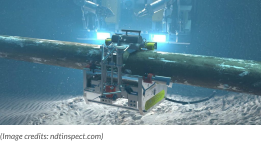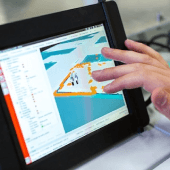INTRODUCTION
The vast expanse of oceans and seas, where subsea and offshore structures stand tall, is also the grounds of the battle between man-made ingenuity and the unyielding forces of nature in marine environments. Structures like oil rigs, pipelines, and underwater cables, are exposed to various environmental factors that can harm their integrity.
The consequences faced by operating in the dynamic and ruthless realm of marine environments are severe, and factors like extreme weather events, seabed conditions, corrosion, wave and current forces, and subsea geohazards can cause failure or damage to these structures.
Failure or damage of such structures may cause major oil spills, interruption of energy supplies, contamination of the environment, and risk to human health and life.
The need for increased safety measures, environmental preservation, or stricter regulations was realized as recently as 2010. The phenomenon that caused it was the blowout in the Deepwater Horizon rig, induced by the failure of its safety systems, which also included the failure of the blowout preventer (BOP).
Months-Long Oil Released! Deepwater Horizon Spill, Known as the Macondo Blowout, Ravaged the Sea
The Deepwater Horizon spill, also called the Macondo blowout, released oil into the sea for approximately a period of three months. Multiple fire containment and remedial efforts were made, however, the rig collapsed into the Gulf of Mexico.
This incident caused around 4.9 million barrels of crude oil to be released into the Gulf, causing harm to the marine life and animal life that depended on the water source. This also affected the livelihoods of fishermen and the coaster community and affected tourism in the region.
This event also highlighted the dire need to employ thorough inspection and maintenance of subsea and offshore vehicles and infrastructure. Non-destructive testing caught on as a crucial methodology to evaluate the condition of the components or infrastructures under study and aided in identifying potential points of failure or defects.
The tragic implosion of the Titan submersible built by the American company OceanGate in the North Atlantic Ocean on 18th June 2023, is a testament to the necessity of responsible testing and quality control practices in industries. Numerous safety concerns were dismissed by CEO Mr. Stockton Rush, who asserted that emphasizing safety impedes innovation. As a result of his disregard for safety and testing procedures, Mr. Rush met his untimely demise in the submersible disaster.
TYPES OF NDT METHODS FOR SUBSEA AND OFFSHORE APPLICATIONS
Some of the key Non-destructive testing methods employed in subsea and offshore applications are:
- Visual Inspection (VI)
- Liquid Penetrant Testing (LPT)
- Radiographic Testing (RT)
- Ultrasonic Testing (UT)
- Eddy Current Testing (ECT)
The selection of Non-destructive testing methods depends on the properties of the material under inspection, the accessibility of the test area, and the type of defect being targeted for detection.

ADVANTAGES AND LIMITATIONS OF NDT TECHNIQUES IN SUBSEA AND OFFSHORE APPLICATIONS
The advantages of NDT techniques in subsea and offshore applications are as follows:
- NDT methods do not cause damage to the subject under test; hence they can be used to test subsea and offshore components and structures without affecting their integrity or operability.
- NDT methods can obtain data on potential defects, flaws, and degradation in structures, pipelines, and equipment, consequently contributing to the overall safety of subsea and offshore applications. Premature detection of defects enables timely remedial actions and reduces the probability of accidents, damage to the environment, and loss of revenue due to downtime.
- NDT techniques can provide economical solutions for maintenance and inspection programs for subsea and offshore applications. Identification of areas of concern can enable industries to resources and efforts towards vital elements. This reduces unnecessary maintenance and repair processes.
- NDT permits meticulous analyses of large sections or lengths of subsea pipelines and structures. Advanced techniques like PAUT and GWT, enable faster data acquisition and provide data on defects and deformities.
- NDT techniques are versatile and apply to a variety of materials that include metals, composites, and non-metals. This versatility permits the inspection of a variety of test subjects.
The disadvantages of NDT techniques in subsea and offshore applications are as follows:
Smaller or hidden defects are often hard to detect using NDT. The sensitivity of the method and operators’ knowledge and skill can affect the detection capabilities. This may lead to errors or misinterpretation of defects.
- NDT methods require skilled and trained operators. Operating the equipment, acquiring data, and making correct inferences are of utmost priority.
- Some NDT techniques require specific surface conditions (e.g., Ultrasonic Testing) to obtain optimal results. Subsea and offshore environments may cause corrosion and marine growth on test subjects, and prior surface preparation may be required to conduct tests.
- Equipment limitations hinder the testing process. Depth restrictions, Inaccessibility, and environmental factors contribute to the ability of the test apparatus to operate.
- Skilled interpretation of results is essential to determine the extent and significance of damage on test subjects, as well as remedial actions. Test outcomes may vary between operators, leading to inconsistencies in data.
- It is imperative to consider the advantages and disadvantages of NDT methods while implementing them in subsea and offshore applications. Thorough comprehension, planning, and training are essential to maximize the benefits of Non-destructive testing.
APPLICATIONS OF NDT METHODS IN SUBSEA AND OFFSHORE INDUSTRIES
Non-destructive testing has numerous applications in the subsea and offshore industries. Non-destructive testing methods are employed to gauge the quality, safety, and structural integrity of subsea and offshore equipment, components, and structures.
Some key applications of NDT methods in subsea and offshore industries include:
- Subsea pipelines: NDT techniques like Magnetic Particle Inspection (MPI) and ultrasonic testing are used to assess subsea pipelines for the presence of defects and corrosion. These methods can also be used to check the pipeline wall thickness. Potential leaks and failures can be anticipated using these methods.
- Subsea risers: Subsea risers connect subsea wellheads to the surface facilities. Methods like Ultrasonic Testing (UT), Visual Inspection (VI), etc. are used to check for any defects, deterioration, or cracks. This helps evaluate any potential risks to the risers’ integrity.
- Subsea structures: Subsea structures (e.g., platform jackets or subsea manifolds) are often inspected using techniques like Visual Inspection (VI) and Acoustic Emission Testing (AET). These assessments aid with the detection of fatigue cracks, damage, or corrosion that may cause failure in the structural integrity of such structures.
- Blowout preventers (BOP): BOPs are safety devices that help control oil and gas well blowouts. BOP components (e.g., shear rams and hydraulic systems) are assessed using techniques like Ultrasonic Testing (UT) and Radiographic Testing (RT).
- Weld Inspection: NDT techniques such as Magnetic Particle Testing (MPT), Ultrasonic Testing (UT), and Radiographic Testing (RT) are used to test for weld defects such as cracks, porosity, or insufficient fusion. Welds in subsea pipelines, offshore platforms, and structural components.
- Detecting corrosion: Corrosion-related deterioration may be tested using NDT techniques such as Ultrasonic Testing (UT), Radiographic Testing (RT), and visual inspection (VI). Subsea and offshore industries depend on NDT techniques to evaluate the state of corrosion in structures, equipment, and pipelines.
- Thickness Measurement: Electromagnetic Testing techniques such as Eddy Current Testing (ECT) and Eddy Current Array Testing (ECA) aid in the thickness measurement of structural components, pipelines, and vessels. Apart from the structural integrity, thickness measurement helps gauge the thinning due to corrosion or erosion and helps assess the lifetime of the subject.
- Material Composition: The quality and properties of materials used in offshore and subsea applications can be evaluated using NDT methods like Ultrasonic Testing (UT), Radiographic Testing (RT), and Magnetic Particle Testing (MPT). This helps verify the materials’ adherence to the industry specification, standards, and regulatory requirements.
- Condition Monitoring: NDT methods like Acoustic Emission Testing (AET) AND Vibration Analysis are used to analyze the acoustic or vibration signals emitted from the structure under inspection. This ensures the detection of degradation, deformities, and defects, ensuring thorough maintenance and prevention of structural failure.
- Offshore Platform Inspection: The structural integrity, presence of weld defects, corrosion, etc. of an offshore platform are detected using NDT techniques like Visual Inspection (VI), Magnetic Particle Testing (MPT), Radiographic Testing (RT), and Ultrasonic Testing (UT).
Regulatory requirements, test subject characteristics, working environment, and other factors play an important role in the testing procedures, frequency, and modus operandi. NDT methods have great potential in the subsea and offshore industry and are critical to their smooth operation.
EMERGING TECHNOLOGIES IN NDT FOR SUBSEA AND OFFSHORE
Technological advancements have led to an evolution in the field of Non-destructive Testing. Efficient and accurate testing methodologies are of priority to meet modern-day technological demands.

Some of the emerging techniques in Non-destructive testing for subsea and offshore industries are:
- Phased Array Ultrasonic Testing (PAUT): Phased Array Ultrasonic Testing uses multiple transducers to induce and receive ultrasonic waves. The transducer elements can be controlled and their properties like amplitude etc. can be adjusted to electronically scan a component or structure. PAUT can be used to inspect weld defects, pipelines, and other vital elements in a subsea and offshore structure.
- Digital Radiography: This technique employs the use of digital detectors instead of radiographic films to obtain X-ray and Gamma-ray images. Difficult-to-access areas in subsea and offshore structures can be tested using this NDT method as it provides real-time image manipulation and analysis, faster image acquisition, and sharper images.
- Eddy Current Array Testing (ECA): Eddy Current Array Testing is an advanced method of Eddy Current Testing that can be used on conductive materials to check for surface and near-surface defects. ECA uses an array of sensors to provide a quick and thorough inspection of non-ferromagnetic elements of subsea and offshore structures and components.
- Remote Visual Inspection (RVI): This method uses remotely operated cameras and robotic mechanisms to inspect hard-to-access areas. RVI can conduct visual inspections using mobility mechanisms, lighting, and advanced cameras to assess subsea structures, equipment, and pipelines.
- Time-of-flight Diffraction (TOFD): This NDT method utilized diffracted signals to detect defects in welds and other elements. This method provides depth sizing and imaging, making it an efficient choice to assess welds in subsea and offshore structures and elements.
- Guided Wave Testing (GWT): GWT employs the use of low-frequency guided ultrasonic waves to evaluate long lengths of structures or pipelines from a single access point. This method is useful in detecting variations in wall thickness along the length of the test subject, corrosion, and erosion. The test area covered from a single access point is large in the case of GWT, hence making it a viable testing option for large-scale structures and machinery.
- Artificial Intelligence and Machine Learning: Artificial Intelligence and Machine Learning are being used to automate NDT testing processes using data analysis, predictive analytics, and pattern recognition. The transition of the field of NDT into Industry 4.0 uses such techniques to enable efficient evaluations in subsea and offshore environments.
The future of NDT is bright and illustrated with newer technologies that provide improvements in speed, accuracy, inspection, and data analysis which help ensure the longevity and safety of essential components and structures in the offshore and subsea industry.
CONCLUSION
The fundamental concepts of Non-destructive testing, which include techniques like Ultrasonic Testing, Radiographic Testing, Visual Inspection, and Magnetic Particle Testing provide a deeper perspective into the state of offshore and subsea equipment and their reaction to their environment with time.
Detection of defects, anomalies and degradation using NDT methodologies ensures timely maintenance, repair, and replacement of damaged or vital elements. This safeguards industries from untoward incidents and hazards to human life.
The domain of Non-destructive testing methods is ever expanding due its to demand and relevance to modern engineering, and methods like Phased Array Ultrasonic Testing, Guide Wave Testing, and Radiographic Testing provide vital data on a large variety of subjects, which helps elevate the quality of human engineering capabilities.
The amalgamation of Artificial Intelligence and Machine Learning with NDT technology has kick-started the possibility of automated operations and testing. Efficient maintenance strategies can be planned with these methods, which in turn increases their reliability.
Researchers, industries, and governing bodies need to collaborate to keep up with NDT methods with the constant evolution of the subsea and offshore industries. Non-destructive testing is a vital element of risk mitigation, quality assurance, and asset integrity management. By efficiently utilizing the principles of Non-destructive testing and newer technology, we can navigate the complex challenges of subsea and offshore operations and build a culture of safety, reliability, and responsibility towards the environment.
-min.jpg)












